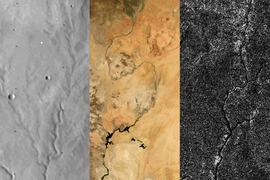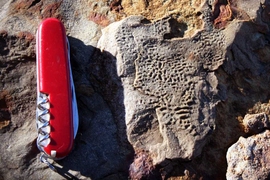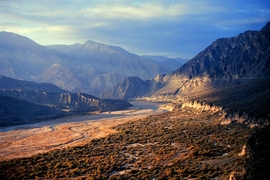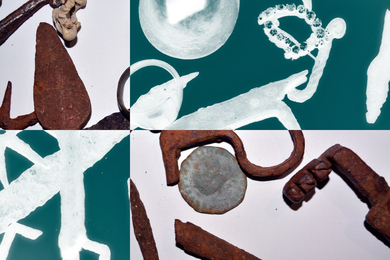The environment on Titan, Saturn’s largest moon, may seem surprisingly familiar: Clouds condense and rain down on the surface, feeding rivers that flow into oceans and lakes. Outside of Earth, Titan is the only other planetary body in the solar system with actively flowing rivers, though they’re fed by liquid methane instead of water. Long ago, Mars also hosted rivers, which scoured valleys across its now-arid surface.
Now MIT scientists have found that despite these similarities, the origins of topography, or surface elevations, on Mars and Titan are very different from that on Earth.
In a paper published today in Science, the researchers report that Titan, like Mars but unlike Earth, has not undergone any active plate tectonics in its recent past. The upheaval of mountains by plate tectonics deflects the paths that rivers take. The team found that this telltale signature was missing from river networks on Mars and Titan.
“While the processes that created Titan’s topography are still enigmatic, this rules out some of the mechanisms we’re most familiar with on Earth,” says lead author Benjamin Black, formerly an MIT graduate student and now an assistant professor at the City College of New York.
Instead, the authors suggest Titan’s topography may grow through processes like changes in the thickness of the moon’s icy crust, due to tides from Saturn.
The study also sheds some light on the evolution of the landscape on Mars, which once harbored a huge ocean and rivers of water. The MIT team provides evidence that the major features of Martian topography formed very early in the history of the planet, influencing the paths of younger river systems, even as volcanic eruptions and asteroid impacts scarred the planet’s surface.
“It's remarkable that there are three worlds in the solar system where flowing rivers have carved into the landscape, either presently or in the past,” says Taylor Perron, associate professor of geology in MIT’s Department of Earth, Atmospheric and Planetary Sciences (EAPS). “There’s this amazing opportunity to use the landforms the rivers have created to learn how the histories of these worlds are different.”
Perron and Black’s co-authors include former MIT undergraduate Elizabeth Bailey and researchers from the University of California at Berkeley, the University of California at Santa Cruz, and Stanford University.
Fuzzy flows
Since 2004, NASA’s Cassini spacecraft has been circling Saturn and sending back to Earth stunning images of the planet’s rings and moons. Images of Titan’s surface have given scientists a first view of the moon’s river valleys, rolling sand dunes, and active weather patterns. Cassini has also made rough measurements of Titan’s topography in some locations, though these measurements are much coarser in resolution.
Perron and Black wondered whether they might refine their view of Titan’s topography by applying what is known about the topography on Earth and Mars, and how their rivers have evolved.
For instance, on Earth, the process of plate tectonics has continuously reshaped the landscape, pushing mountain ranges up between colliding continental plates, and opening ocean basins as landmasses slowly pull apart. Rivers, therefore, are constantly adapting to changes in topography, sidestepping around growing mountain ranges to reach the ocean.
Mars, on the other hand, is thought to have been shaped mostly during the period of primordial accretion and the so-called Late Heavy Bombardment, when asteroids carved out massive impact basins and pushed up huge volcanoes.
Scientists now have well-resolved maps of river networks and topography on both Earth and Mars, along with a growing understanding of their respective histories. Perron and Black used this foundation to gain insight into Titan’s topographic history.
“We know something about rivers, and something about topography, and we expect that rivers are interacting with topography as it evolves,” Black says. “Our goal was to use those pieces to crack the code of what formed the topography in the first place.”
Conforming with topography
The team first compiled a map of river networks for Earth, Mars, and Titan. Such maps were previously made by others for Earth and Mars; Black generated a river map for Titan using images taken by Cassini. For all three maps, the researchers marked the direction each river appeared to flow.
They then compared topographic maps for all three planetary bodies, at varying degrees of resolution. Maps of Earth are sharp in detail, as are those for Mars, showing mountain peaks and impact basins in high relief. By contrast, due to Titan’s thick, hazy atmosphere, the global map of Titan’s topography is extremely fuzzy, showing only the broadest features.
In order to make direct comparisons between topographies, the researchers dialed down the resolution of maps for Earth and Mars, to match the resolution available for Titan. They then superimposed maps of each planetary body’s river networks, onto their respective topographies, and marked every river that appeared to flow downhill.
Of course, rivers only flow downhill. But the team observed that rivers might appear to flow uphill, simply because a map at low resolution may not capture finer details such as mountain ranges which would divert a river’s flow.
When the researchers tallied the percentage of rivers on Titan that appeared to flow downhill, the number more closely matched with Mars. They also compared what they called “topographic conformity” — the degree of divergence between a topography’s slope and the direction of a river’s flow. Here too, they found that Titan resembled Mars over Earth.
“One prediction we can make is that, when we eventually get more refined topographic maps of Titan, we will see topography that looks more like Mars than Earth,” Perron says. “Titan might have broad-scale highs and lows, which might have formed some time ago, and the rivers have been eroding into that topography ever since, as opposed to having new mountain ranges popping up all the time, with rivers constantly fighting against them.”
Filling in a picture
One last question the researchers looked to answer was how cratering due to asteroid impacts on Mars has reshaped its topography.
Black used a simulation that the group previously developed, to model river erosion on Mars with different impact cratering histories. He found that the pattern of river networks on Mars today limits the extent to which cratering has remodeled the surface of Mars. This suggests that the biggest impact craters formed very early in Mars’ history, and that later pummeling by asteroids mostly dented and dinged the surface.
As Cassini’s mission is scheduled to come to an end in September, Perron says further investigation of Titan’s surface will help to guide future missions to the distant moon.
“Any way of filling in the details of what Titan’s surface is like, beyond what we can see directly in the images and topography Cassini has collected, will be valuable for planning a return,” Perron says.
This research was funded, in part, by NASA.












